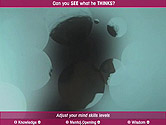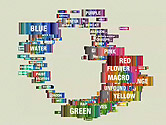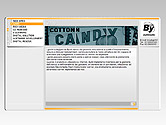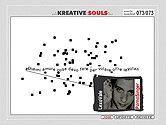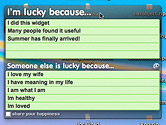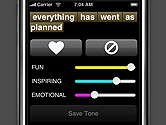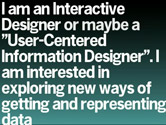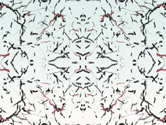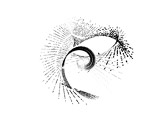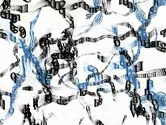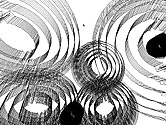Rich Interactive and Aesthetically Pleasant Experiences
(1999 - 2009 by Christian Giordano)This site contains a resume of my first 10 years of exploration in the expressiveness and engagement of Interactive Media.
I will go through the essential parts and principles of my very personal journey, but before we start you might want to have a peek at what it has been all about...
Background
My discovery of the potentials of digital technologies began in the '90s when I started creating cheesy covers for my DJ sets using Photoshop filters.
Those bright colors covers looked great printed, at least to me, but they didn't engage me enough.
With what at that time was called Multimedia, I would have been able to add to my cheesy graphics, music and animations too. It sounded great!
But even if Lingo resembled English,
it was only in the 1999 that the incredible results people like Yugo Nakamura could achieve with Macromedia Flash 4
helped me to be patient enough to start writing many lines of text (code) without any visual feedback, except eventually after compilation, eventually!
Quite some time passed since then, and my primary focus became the web because its very broad audience and powerful social capabilities.
It has been a pretty intensive learning process because I had to face many design and technical challenges.
Surely, my thoughts and knowledge wouldn't be to the level they are now and I wouldn't have been able to keep my beliefs continuously under discussion if I hadn't been so blessed to have met and worked with such enlightened people.
I really do hope I contributed to their journeys as they did to mine.
It was a while I wanted to distillate my personal journey and the 10 years anniversary gave me enough motivation and inspiration.
Despite it doesn't really feel so long, many little and less little projects passed through my head during this time, and some got eventually developed.
I like to talk about the subject and I have really strong opinions about some arguments, but I still prefer doing than talking.
While the most recent projects are clearly more complete and take into consideration many aspects of the user experience,
I still value my very early and banally simple experiments.
User Interface Design
As soon as your projects start accepting more than simple inputs from the user, using functionalities, or maybe just to navigate within it, you will start becoming responsible for important decisions which will affect drastically if and how the user will interact with them.
It is true there are some interaction paradigms which are permeating into our culture as standards and it is important to take them into consideration but, because of the very young and dynamic state of the field, they will never cover all the required solutions and I'm sure many of them can be put under discussion:
do we need so many mouse clicks, or in some cases gestures or are mouse over events are more appropriate? And what about double-clicks?
Also the involvement of different people, or even worse different companies, in the market can't really push global standards.
So whether you want it or not, soon or later you will have to use your creativity to challenge popular solutions or to create something totally new.
These days people deal with an incredible amount of different Graphical User Interfaces (GUIs) everyday (mobile, applications, websites, cash machines, sat navs, etc...), this is making people very capable to adapt to new ones, so don't be too scared to try new solutions.
But Designing for rich interactive media can easily carry you away and make you create fancy but unnecessary animations.
It definitely happened to me, so when I realized it I started exploring when these rich interactions can be more helpful, sometimes, for instance, to make things more practical and sometimes to maintain the user attention (which can be very volatile).
This became a bit of a mission and in 2003-04 I collaborated with FlashAbility (Flash + Usability).
Social Software
This has been the era of the Rich Internet Applications (RIAs), I remember when Macromedia was marketing the term (2002), they related it to rich GUI's interactivity (eg. drag and drop) and rich content (videos).
Features which were definitely new for the medium but didn't sound that exciting.
What should be fully integrated in the term "rich" is data.
Obviously digital means anything is converted into data, but more precisely the web is an incredible bridge to endless information where you can record and share as much.
It's true we like to share our experiences and feelings together, but the web taught me that
asynchronous experiences are as worthy to be shared (other examples: Facebook or Twitter), so never under estimate the social power of databases.
As a designer, I like not to waste any opportunity where users can interact with each other, the web should be all about sharing.
For this reason as an author I can hardly stand when other authors don't respect and follow people comments, or even worse they don't even allow people to comment at all! (#fail).
Research
My journey has been a continuous research, mainly for new and useful usages of technology and data through design. New digital information and tools bring new problems to solve but also strengths and potentialities. Because digital involves so many aspects of our lives, the concepts developed vary from pure digital (eg. InfoVis), to more physical, including also interaction with handheld devices.
Aesthetic
Works good and looks good, ok, the substance is important but the reality is that we don't want to be involved in anything which resemble ugliness.
In fact, aesthetic affects directly the usability.
You can create amazing abstract images designing computational generative systems, but I've never been enough patient for it or using Photoshop.
I always found playing with typography fascinating though, because being both shape and function (but the real master is Peter Cho).
With interactive objects, it is important to give attention also to the aesthetic of the interaction.
This doesn't mean just providing clear and pleasant feedback for any given user action, but also that these feedback had to be returned promptly.
A slowly reactive system is ugly, and unusable.
My passion for Motion Graphics helped me on developing an imagination for time based visual reactivity.
Among all the various artists which I've been inspired from, MK12 Studios and the nutter GMunk deserve more than just a mention.
An interesting thing when you deal with animations, is the illusion you can create.
Any magician knows well how an audience hardly notices malfunctions
if properly distracted.
Some old school graphic designers might consider it cheating and instigating to imperfection, but clearly each visual media should have its own definition of the aesthetically perfect.
Fun
During my attempts in designing useful and meaningful experiences through new interaction metaphores, sometimes I came out with
original ideas which were pretty silly, obviously someone could make a considerable living from those, but for me it was just fun.
As much fun was to work for
commercial projects of very artistic nature.
You can be very serious and focused on your work and mission, but sometimes breaking the rules is helpful, and fun!
Details and Love
Details are one of the main differences between design and grand design, they can easily be lost if there is no love in what you do. I am always so overwhelmed when I can see someone else love and dedication that one of my objectives when I work on a project is to be able to communicate the love and dedication that I certainly have. This definitely has to come as well as through details. Also if only few people recognize and appreciate the effort, it will be worth it. Share the love!
Follow Up
Any comment is very welcome but if you prefer Twitter, you can either
tweet to me,
tweet about it or
follow me.
If you really have to, of course, you can also contact me privately.
